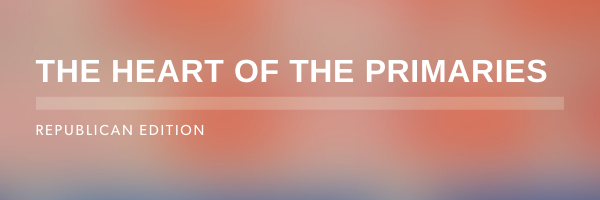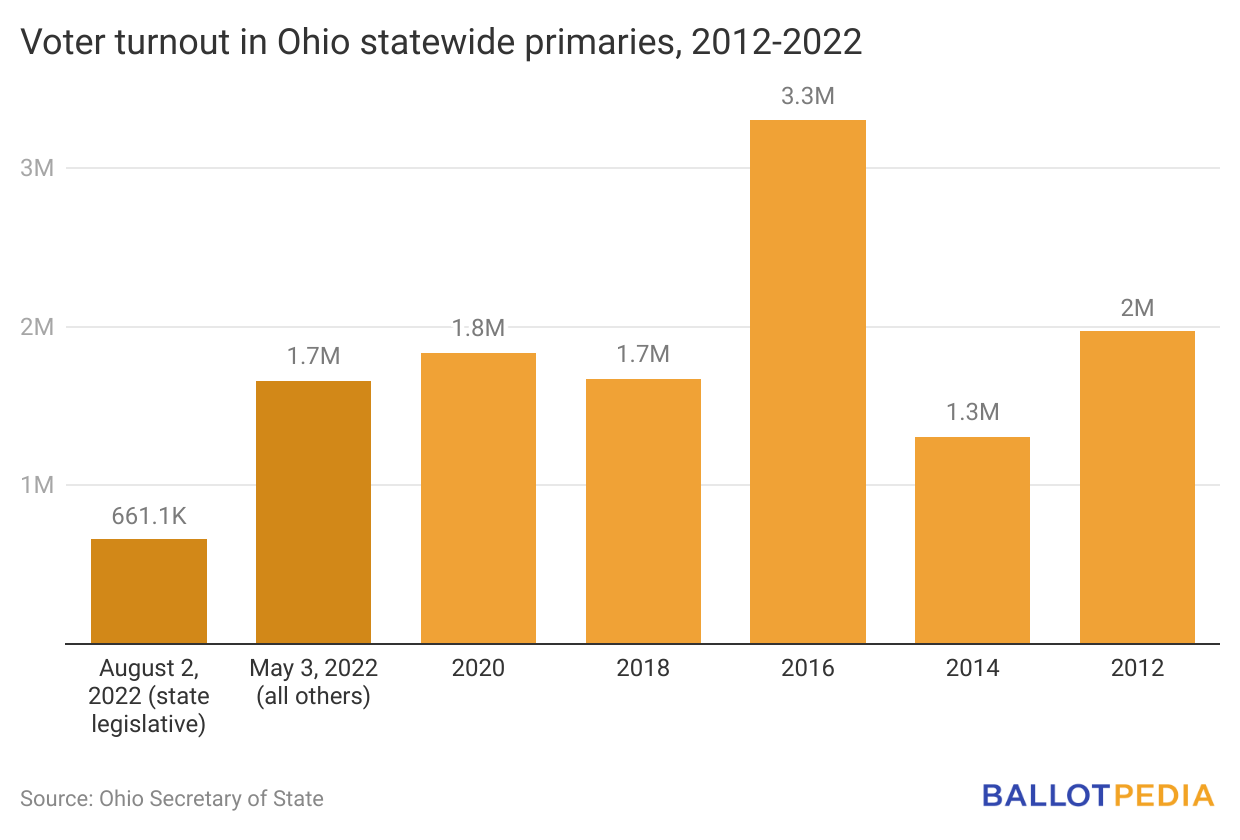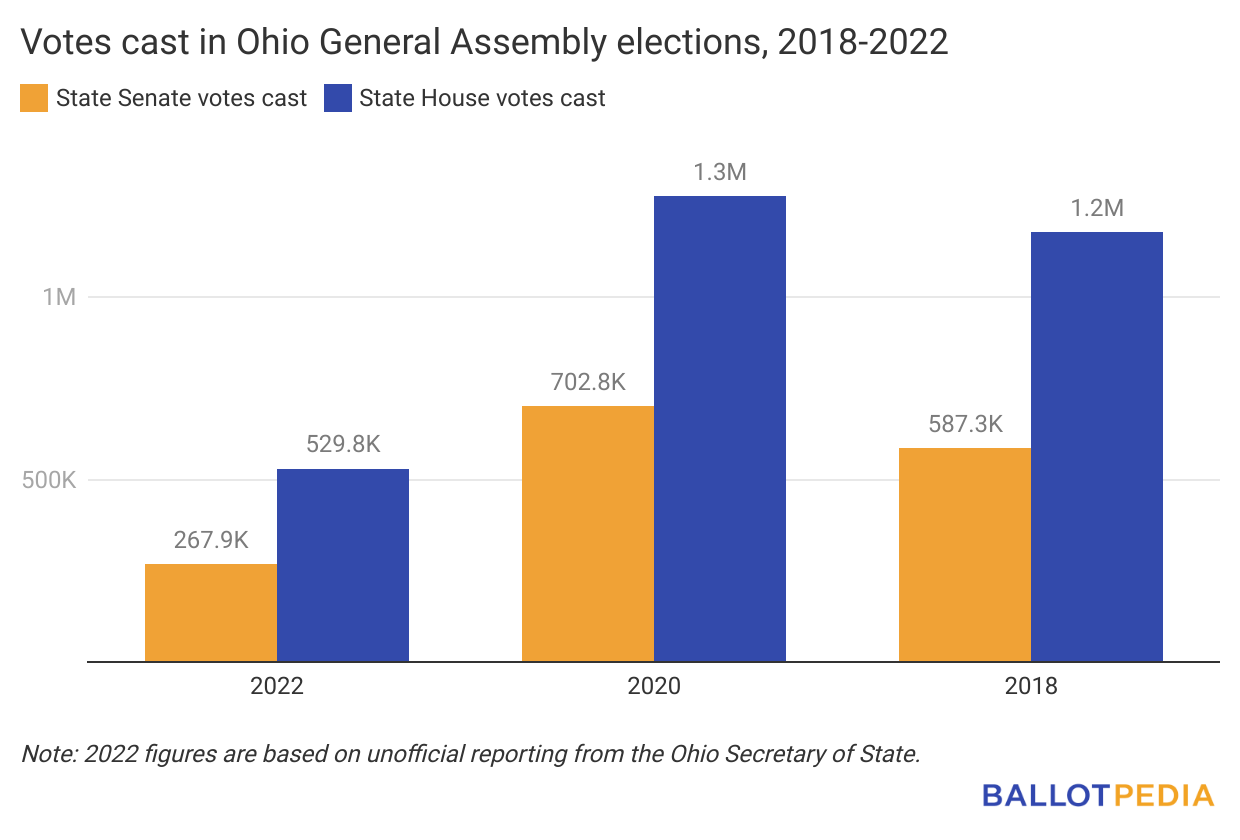|
|
 |
|
|
Welcome to Heart of the Primaries, Republican Edition
|
|
|
September 01, 2022
|
|
|
|
In this issue: Boston Globe backs Doughty in GOP gubernatorial primary and a look at turnout in Ohio's split primaries. |
|
|
|
|
|
|
|
BALLOTPEDIA |
|
|
|
|
|
|
Globe backs Doughty in Massachusetts gubernatorial primary
|
|
|
|
|
|
|
The Boston Globe editorial board wrote that "reasonable conservatives need to mobilize for Chris Doughty" in the GOP gubernatorial primary and "reset the Massachusetts state Republican Party by pulling it from the grip of Donald Trump."
Doughty faces former state Rep. Geoff Diehl (R), who Trump endorsed before Republican Gov. Charlie Baker announced he wouldn't seek re-election. Trump and Baker have criticized one another. Baker hasn't endorsed in the primary.
Before the Globe published its endorsement, Diehl said he refused to meet for an endorsement interview and called the paper's editorial page "essentially just a bulletin board for left-wing progressive talking points and utopian daydreams."
Doughty said at a July debate, "Geoff cannot win running as an Alabama Republican in the state of Massachusetts." Doughty has emphasized his business background and says he is equipped to address the high cost of living in the state.
Diehl highlighted that he won 71% of the state party convention endorsement vote and criticized Doughty for voting for Hillary Clinton (D) for president in 2016. Diehl says his record includes keeping gas taxes low and has emphasized his opposition to mask mandates.
New Hampshire Gov. Chris Sununu (R) has campaigned for Doughty, while South Dakota Gov. Kristi Noem (R) has campaigned for Diehl.
As of 2021, 10% of the state's registered voters were Republican, compared to 57% unenrolled and 32% Democratic (unenrolled voters can vote in party primaries in Massachusetts).
The primary is Sept. 6. |
|
|
|
|
|
|
Peltola wins special U.S. House election (and other Alaska updates)
|
|
|
|
|
|
|
On Aug. 16, Alaska held top-four primaries and a special U.S. House election, the latter of which used ranked-choice voting. Certification is expected by tomorrow, and most battleground races have been called.
U.S House special general: Mary Peltola (D) won the election. On the final round of unofficial ranked-choice voting tabulation, Peltola had 51.5% of the vote to Sarah Palin's (R) 48.5%. This election fills the term ending Jan. 3, 2023.
Before tabulation began, Peltola had 40% of first-choice votes, followed by Palin with 31% and Nick Begich III (R) with 28%. Write-in candidates received a combined 1.6% of the vote.
Write-in candidates were eliminated first as a batch. Then Begich was eliminated. The votes of those who chose eliminated candidates as first choices were redistributed to the voters' second-choice candidates if they chose such. Watch a livestream of the tabulation from the Alaska Division of Elections here.
Peltola will be Alaska's first Democratic U.S. representative since Nick Begich Sr.—Nick Begich III's grandfather. Begich Sr.'s plane went missing while he was in office in 1972. Don Young (R) won a special election to succeed Begich. Young served until his death in March of this year.
Peltola, Palin, and Begich will meet again in the regularly scheduled general election for U.S. House in November. General elections for all offices below will be held Nov. 8 and will use ranked-choice voting as well.
U.S. House regular primary: As of Wednesday, The New York Times had called three of the four general election spots for Peltola, Palin, and Begich III. Peltola led with 37% of the vote, followed by Palin with 30%, Begich with 26%, and Tara Sweeney (R) with 4%.
Sweeney said she'll withdraw from the race, meaning the fourth spot would go to the fifth-place finisher. As of Wednesday, that was Libertarian Chris Bye, who had 0.6% of the vote. Sept. 2 is the target election certification date, and Sept. 6 is the ballot certification date.
Alaska governor: Incumbent Mike Dunleavy (R), Bill Walker (Independent), Les Gara (D), and Charlie Pierce (R) advanced to the general election. Dunleavy had 41% of the vote, followed by Walker and Gara with 23% each and Pierce with 7%.
Dunleavy was elected governor in 2018. He succeeded Walker, who initially ran for re-election that year and withdrew weeks ahead of the general election. Gara served in the state House of Representatives from 2003 to 2019. Pierce worked as a manager at ENSTAR Natural Gas Company.
U.S. Senate: Incumbent Lisa Murkowski (R), Kelly Tshibaka (R), Patricia Chesbro (D), and Buzz Kelley (R) advanced to the general election. Murkowski had 45% of the vote, followed by Tshibaka with 39%, Chesbro with 7%, and Kelley with 2%.
Murkowski first took office in 2002. Tshibaka is a former commissioner at the Alaska Department of Administration. Chesbro is a retired teacher. Kelley is a retired mechanic.
Murkowski is the only Republican senator seeking re-election this year who voted guilty during former President Donald Trump's 2021 impeachment trial. Murkowski's endorsers include U.S. Senate Minority Leader Mitch McConnell (R) and Sens. Dan Sullivan (R-Alaska), Joe Manchin (D-W.V.), and Kyrsten Sinema (D-Ariz.). Trump and the Alaska Republican Party endorsed Tshibaka. |
|
|
|
|
|
|
Louisiana Lt. Gov. Nungesser says he'll run for governor next year
|
|
|
|
|
|
|
Lt. Gov. Billy Nungesser (R) said that he plans to run for governor of Louisiana in 2023. The Associated Press also listed U.S. Sen. Bill Cassidy, U.S. Rep. Garret Graves, state Treasurer John Schroder, and Attorney General Jeff Landry as possible Republican contenders.
AP wrote, "Louisiana is the rare conservative state to have a Democratic governor. The moderate [Gov. John Bel] Edwards won hard-fought races in 2015 and 2019, but he is unable to seek a third consecutive term due to term limits. That means 2023 is a huge opportunity for Republicans to take control of the state that voted for Donald Trump by wide margins in the past two presidential contests."
According to the Louisiana Secretary of State office, 40% of registered voters are Democrats, 33% are Republicans, and 27% have a different affiliation. FiveThirtyEight gives the state a partisan lean—a measure of how the state votes compared to the country as a whole—of R+20.5.
Louisiana uses a majority-vote system in which all candidates, regardless of party, run in a preliminary election. If a candidate wins a majority of the vote, they win the election outright. Otherwise, the top two finishers advance to a second election.
Nungesser defeated Willie Jones (D) outright in 2019's preliminary election for lieutenant governor.
Edwards and Eddie Rispone (R) advanced from the preliminary gubernatorial election that year with 47% and 27%, respectively. Edwards won the final election 51.3%-48.7%.
Of the 17 states that elect governors and lieutenant governors separately, Louisiana, North Carolina, and Vermont have governors and lieutenant governors of different parties. |
|
|
|
|
|
|
Ohio's state legislative primary voter turnout decreased amid split election
|
|
|
|
|
|
|
Due to redistricting-related court challenges, Ohio held two primaries this year. The first, its regularly scheduled primary, took place on May 3 for all except state legislative offices. State legislative primaries occurred on Aug. 2. Turnout in the May 2022 primary was comparable to 2018 and 2020 primary turnout, while state legislative primary turnout specifically was lower this year than in 2018 and 2020.
The chart below compares unofficial voter turnout numbers in the Aug. 2 primary with official turnout numbers in the May primary, along with the official turnout numbers in the state’s previous primary elections through 2012.

Ohio’s Aug. 2 primary had the lowest voter turnout in a statewide primary election in at least a decade, with 661,101 votes cast. A look at votes cast in General Assembly elections in previous years shows that fewer people voted in these primaries in 2022. Votes cast in state Senate elections were 38% of the 2020 figure and 46% of the 2018 figure. In state House elections, 2022 primary votes were 41% of the 2020 figure and 45% of the 2018 figure. The chart below shows the total votes cast in state House and state Senate elections in 2022, 2020, and 2018.

Note: Ohio holds elections for all state House districts and half its state Senate districts in even-numbered years.
The Ohio Redistricting Commission's state legislative maps underwent a lengthy legal challenge process involving several map submissions to the Ohio Supreme Court. A federal court order went into effect on May 28, selecting one of the submitted maps for use in the 2022 elections. The legal challenge to the legislative maps is ongoing before the state supreme court.
Ohio is one of two states that split its primaries this year due to redistricting legal challenges. Statewide turnout data is not yet available in New York, which held primaries on June 28 and Aug. 23. |
|
|
|
|
|
|
Competitiveness data: Massachusetts
|
|
|
|
|
|
|
We’ve crunched some numbers to see how competitive Massachusetts’ Sept. 6 primaries are compared to recent cycles.
 
Notes on how these figures were calculated:
-
Candidates per district: divides the total number of candidates by the number of districts holding elections.
-
Open districts: divides the number of districts without an incumbent running by the number of districts holding elections.
-
Contested primaries: divides the number of major party primaries by the number of possible primaries.
-
Incumbents in contested primaries: divides the number of incumbents in primaries by the number seeking re-election in the given election cycle.
|
|
|
|
|
|